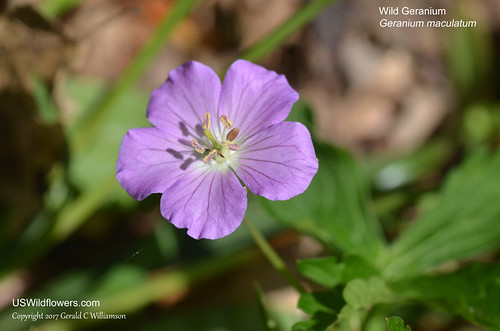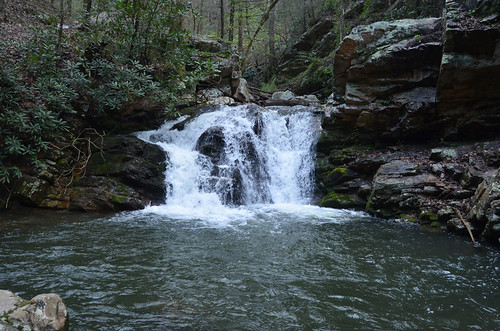A discussion on Facebook a few days ago reminded me that the Collins Gulf area of Savage Gulch State Natural Area in Grundy County, TN was on my list of areas I wanted to check out for wildflowers. Originally I had targeted it because of reports of Fringed Phacelia (Phacelia fimbriata), but when I photographed that species in the Smokies, Collins Gulf got bumped down a few places on my list. But I wanted to get into a wilderness with my grandson while he was on spring break this week, so I bumped it back up. Checking the weather, Tuesday, April 4, was forecast as the best day, and this time the weatherman was right – rain on Monday gave us good water for the waterfalls, and a beautiful, sunny day showed up Tuesday morning – as forecast. Grandson Joseph and I headed out about 9 AM for the 50-mile drive to the Collins Gulf West Trailhead of Savage Gulch, for Waterfalls and Wildflowers (31 species; see the list at the end of the post.)
Category Archives: Trail Reports
Piney River Trail #Wildflowers List 04/08/2016
I’d seen (on Facebook) and heard (passerby on Chestnut Top Trail in the Smokies a week or so ago) about Piney River Trail near Spring City. Due to some cancelled plans, Friday, 04/08/2016 became available, so even though the weather was sketchy, I decided to drive the 65 miles to the trail to check it out for myself. It exceeded expectations both for wildflowers, and for simply being a fun, beautiful trail.
#Waterfalls and #Wildflowers – Gee Creek Wilderness
It had been a couple of years since I had walked in Gee Creek Wilderness. Since it was spring break for some of my grandkids, the spring ephemerals were in full swing, and it promised to be good weather, I headed to Gee Creek with two of my grandsons (Noah and Philip) for a walk along the creek on Friday, April 1, 2016.
Wildflower Report: Sitton’s Gulch, Cloudland Canyon State Park
The Georgia Botanical Society made their trip to Cloudland Canyon State Park on Saturday, April 11, and I saw their photo report on Facebook. That, and a report from Richard Ware’s Sunday trip to the same location, inspired me to take advantage of a break in this week’s rain on Tuesday to get back over to Sitton’s Gulch to see the Dwarf Larkspur, Southern Red Trillium, and other wildflowers. It was a great choice, with at least 34 species of wildflower observed.
The rest of the story…
Elsie Holmes Nature Park near Ringgold, Georgia
Rainy days… Tired of them. Sunday, 3/15/2015, promised to be beautiful, and it delivered. During the week I got an email from someone mentioning seeing some spring wildflowers at Elsie Holmes Nature Park near Ringgold, Georgia (Thanks, Jane!). I had heard of this park before, and had it on my “someday” list, so my wife and I decided to head over there after lunch with some grandkids at Clyde’s on Main. Great place! (Both Clyde’s and Elsie Holmes Park.)
A Visit to the Chattanooga #Riverwalk – Mink and More
The “Polar Vortex” came through the Chattanooga area in mid-July, giving us a few days respite from the muggy heat that usually oppresses us in July and August. It would have been horrible to waste that time indoors, so my wife and I spent a little bit of time on Chattanooga’s Tennessee River Walk at one of our favorite spots, the pond at Curtain Pole Road. We started out chasing dragonflies, but soon that turned into much more.
It’s Not Spring #Wildflowers in the #Smokies, but…
My wife, two granddaughters, and I spent the week prior to July 4 in and around the western part of the Great Smoky Mountains National Park. We spent four nights dry camping in our motorhome in the Park’s Cosby Campground – a beautiful place – and then moved for the final three nights to a nice RV park about halfway between Cosby Campground and Gatlinburg.
While it isn’t springtime in the Smokies, there were still a lot of wildflowers to be seen. I thought I’d share photos of a few of them, four three of which are “lifers” for me (in my haste I originally identified the white Monarda as Monarda bradburiana; I now believe it to be Monarda clinopodia.)
Grassy Mountain #Wildflower Trip May 2014 – Hunting for Cypripedium parviflorum
Grassy Mountain is a 3600’+ peak in Murray County, Georgia, just outside the southwest corner of the Cohutta Wilderness. It’s probably best known as the home of Conasauga Lake, which at 3150′ is the highest lake in Georgia. It is formed by a small dam on the headwaters of Mill Creek. I’d spent a lot of time in and around the Cohutta Wilderness in the 90’s, but hadn’t been back much since then, so when I got an email last week from Mike Christison of the Georgia Botanical Society where he mentioned he’d seen Yellow Ladyslippers blooming on Grassy Mountain in the past, and that they were recently blooming at a much lower elevation, I figured this would be a great time for a return trip to the area. In spite of the cool temperatures, wind, and occasional rain, it WAS a great time; my wife and I identified (at least to a genus level) 37 40 different wildflower species in bloom, including this Wideleaf Spiderwort (Tradescantia subaspera.)
#Waterfalls and #Wildflowers – North Chickamauga Creek Pocket Wilderness (Hogskin Loop)
Saturday, March 14, 2014 was a beautiful day with perfect morning temperatures for hiking, and fortunately my grandson Philip had asked me to take him for a hike, so around 9 AM we headed out from Camp Vesper Point for a visit to the nearby North Chickamauga Creek Gorge State Natural Area. This was my grandson’s first visit to the North Chick, and I hadn’t been there in many years, so while I was hoping for wildflowers, I wasn’t sure what to expect.

Sweet Betsy – Trillium cuneatum – were plentiful, but just beginning to bloom.
#Waterfalls and #Wildflowers – Virgin Falls State Natural Area
We usually just call it “Virgin Falls”, both to refer to the 1,551 acre plot of land, as well as the namesake waterfalls occupying the far end of it. The official name for the land, however, is ”Virgin Falls State Natural Area” at least since the state of Tennessee acquired it in 2012. When I visited it previously it was known as “Virgin Falls Pocket Wilderness” and was owned by the Bowater Southern Paper Corporation. Bowater owns and maintains a number of “Pocket Wilderness” areas, and admirable public benefit and, I’m sure, public relations activity. Tennessee acquired the land using a number of funding sources, including a grant from the federal Endangered Species Recovery Land Acquisition Fund. These funds were provided in part due to the presence of Virginia Spirea (Spiraea virginiana), one of the rarest shrubs in North America.
When I heard about Virginia Spirea being in the Virgin Falls area I decided I needed to add that to the USWildflowers Waterfalls and Wildflowers series, and I was fortunate to make an overnight hike into the Virgin Falls State Natural Area on March 8-9 of this year (2013). While many wildflowers were already in full swing down my way in north Georgia, 70 miles north and a bit of elevation gain makes a difference, and this will be more waterfalls and less wildflowers than I expected to report.









